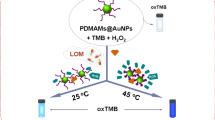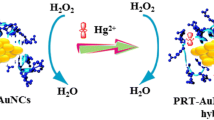Abstract
Recently, nanozymes based on polymer-stabilized gold nanoparticles (AuNPs) have attracted more and more attention on account of their polymer-ligands’ multiple functionalization sites. However, the contribution of polymer hydrogen bonding to the catalytic activity of AuNPs has received little attention. This study designed and fabricated poly(N-2-hydroxypropylmethacrylamide)-capped AuNPs (PHPAM@AuNPs) using a hydroxyl-rich polymer as the ligand. The PHPAM@AuNPs exhibited good peroxidase-mimicking activity capable of efficiently oxidizing 3,3′5,5′-tetramethylbenzidine (TMB) with H2O2. The effect of PHPAM hydrogen bonding on the catalytic activity of PHPAM@AuNPs was investigated. Under peroxidase-mimicking catalysis, homocysteine introduced a notable reduction in oxidation, allowing the creation of a colorimetric method for homocysteine detection with high selectivity and sensitivity. The ultraviolet–visible absorption intensity of oxidized TMB showed a strong linear relationship with homocysteine concentration in the range of 3.0–20.0 μM (R2 = 0.998), with a limit of detection of 0.4 μM. The proposed colorimetric protocol was used to monitor homocysteine in rat serum following intraperitoneal injection. This work provides a new way to refine AuNP-based nanozymes by relying on polymer-ligand hydrogen bonding. It has strong application potential in the analysis of endogenous molecules in real samples.
Graphical Abstract







Similar content being viewed by others
References
Navyatha B, Singh S, Nara S. AuPeroxidase nanozymes: Promises and applications in biosensing. Biosens Bioelectron. 2021;175: 112882.
Lou-Franco J, Das B, Elliott C, Cao C. Gold nanonzymes: From concept to biomedical applications. Nano-Micro Lett. 2021;13:10.
Liu L, Jiang H, Wang X. Functionalized gold nanomaterials as biomimetic nanozymes and biosensing actuators. Trac-Trends Anal Chem. 2021;143: 116376.
Chen J, Wu W, Huang L, Ma Q, Dong S. Self-indicative gold nanozymes for H2O2 and glucose sensing. Chem Eur J. 2019;25:11940–4.
Shi R, Yang J, Cheng S, Qin S, Huang L, Wang Y, Xu Y. Colorimetric determination of biothiols with AuNPs@MoS2 NSs as a perioxidase mimetic enzyme. New J Chem. 2022;46:18718.
Kinnear C, Burnand D, Clift MJD, Kilbinger AFM, Rothen-Rutishauser B, Petri-Fink A. Polyvinyl alcohol as a biocompatible alternative for the passivation of gold nanorods. Angew Chem Int Ed. 2014;53:1–6.
Du Y, Jin J. Liang H and Jiang W Structural and physicochemical properties and biocompatibility of linear and looped polymer-capped gold nanoparticles. Langmuir. 2019;35:8316–24.
Nechikkattu R, Ha CS. Tunable catalytic activity of gold nanoparticle decorated SBA-15/PDMAEMA hybrid system. J Porous Mat. 2020;27:611–20.
Liu F, Liu X, Astruc D, Gu H. Dendronized triazolyl-containing ferrocenyl polymers as stabilizers of gold nanoparticles for recyclable two-phase reduction of 4-nitrophenol. J Colloid Interface Sci. 2019;533:161–70.
Liu F, Liu X, Liu W, Gu H. ROMP synthesis of gallol-containing polymer hydrogels for in situ fabrication of AuNPs and AgNPs composites as recyclable catalysts for the degradation of 4-nitrophenol. Polymer. 2021;219: 123539.
Ansar SM, Kitchens CL. Impact of gold nanoparticles stabilizing ligands on the colloidal catalytic reduction of 4-nitrophenol. ACS Catal. 2016;6:5553–60.
Karthiga D, Choudhury S, Chandrasekaran N, Mukherjee A. Effect of surface charge on peroxidase mimetic activity of gold nanorods (GNRs). Mater Chem Phys. 2019;227:242–9.
Song W, Chi M, Gao M, Zhao B, Wang C, Lu X. Self-assembly directed synthesis of Au nanorices induced by polyaniline and their enhanced peroxidase-like catalytic properties. J Mater Chem C. 2017;5:7465–71.
Li M, Chen G, Bhuyain S. The induction phenomenon and catalytic deactivation of thiolate-stabilized raspberry-like polymer composites coated with gold nanoparticles. Nanoscale. 2015;7:2641–50.
Tsunoyama H, Ichikuni N, Sakurai H, Tsukuda T. Effect of electronic structures of Au clusters stabilized by poly(N-vinyl-2-pyrrolidone) on aerobic oxidation catalysis. J Am Chem Soc. 2009;131:7086–693.
Chakraborty S, Kitchens CL. Modifying ligand chemistry to enhance reusability pH responsive colloidal gold nanoparticle catalyst. J Phys Chem C. 2019;123:26450–9.
Drozd M, Pietrzak M, Parzuchowski P, Mazurkiewicz-Pawlicka M, Malinowska E. Peroxidase-like activity of gold nanoparticles stabilized by hyperbranched polyglycidol derivatives over a wide pH range. Nanotechnology. 2015;26: 495101.
Peletier LA, Gabrielsson J. Impact of enzyme turn over on the dynamics of the Michaelis-Menten model. Math Biosci. 2022;346: 108795.
Yang JY, Wang J, Xiong Z, Yao X, Zhang Y, Ning X, Zhong Y, Liu Z, Zhang Y, Zhao T, Xia L, Zhang K, Liu H. Prevalence and clinical demography of hyperhomecysteinemia in Han Chinese patients with schizophrenia. Eur Arch Psych Clin Neurosci. 2021;271:759–65.
Jakubowski H. Pathophysiological consequences of homocysteine excess. J Nutr. 2006;136:1741S-1749S.
Sohouli MH, Roshan MM, Olusola OF, Fatahi S, Omidi HR, Sharifi P, Hekmatdoost A, Kutbi E, Abu-Zaid A. Impact of omega-2 supplementation on homocysteine levels in humans: a systematic review and mega-regression analysis ofrandomised controlled trials. Nutr Metab Cardiovasc Dis. 2022;22:0939–4753.
Gu YH, Zhang Q, Guo J, Wang F, Bao Y, Qiu Z, Zheng P, Ushijima M, Matsuura M, Xie X, Zhang T. Higher serum homocysteine and lower thyroid hormone levels in pregnant women are associated with neural tube defects. J Trace Elem Med Biol. 2021;68: 126814.
Ma Q, Qiao J, Liu Y, Qi L. Colorimetric monitoring of serum dopamine with promotion activity of gold nanocluster-based nanozymes. Analyst. 2021;146:6615–20.
Steffel LR, Cashman TJ, Reutershan MH, Linton BR. Deuterium exchange as an indicator of hydrogen bond donors and acceptors. J Am Chem Soc. 2007;129:12956–7.
Xu W, Kang Y, Jiao L, Wu Y, Yan H, Li J, Gu W, Song W, Zhu C. Tuning atomically dispersed Fe sites in metal-organic frameworks boosts peroxidase-like activity for sensitive biosensing. Nanomicro Lett. 2020;12:184.
Fan K, Wang H, Xi J, Liu Q, Meng X, Duan D, Gao L, Yan X. Optimization of Fe3O4 nanozyme activity via single amino acid modification mimicking an enzyme active site. Chem Commun. 2016;53:424–7.
Razygraev AV, Taborskaya KI, Petrosyan MA, Tumasova ZN. Thiol peroxidase activities in rat blood plasma determined with hydrogen peroxide and 5,5’-dithio-bis(2-nitrobenzoic acid). Biomed Khim. 2016;62:431–8.
Funding
This work received support from the National Natural Science Foundation of China (No. 21874138).
Author information
Authors and Affiliations
Corresponding authors
Ethics declarations
Conflicts of interest
The authors declare that they have no competing interests.
Additional information
Publisher's note
Springer Nature remains neutral with regard to jurisdictional claims in published maps and institutional affiliations.
Supplementary Information
Below is the link to the electronic supplementary material.
Rights and permissions
Springer Nature or its licensor (e.g. a society or other partner) holds exclusive rights to this article under a publishing agreement with the author(s) or other rightsholder(s); author self-archiving of the accepted manuscript version of this article is solely governed by the terms of such publishing agreement and applicable law.
About this article
Cite this article
Cheng, C., Qiao, J., Zhao, Z. et al. Poly(N-2-hydroxypropylmethacrylamide)-capped gold nanoparticles as nanozymes with peroxidase-mimicking performance for the colorimetric monitoring of serum homocysteine. Anal Bioanal Chem 415, 953–960 (2023). https://doi.org/10.1007/s00216-022-04491-9
Received:
Revised:
Accepted:
Published:
Issue Date:
DOI: https://doi.org/10.1007/s00216-022-04491-9




